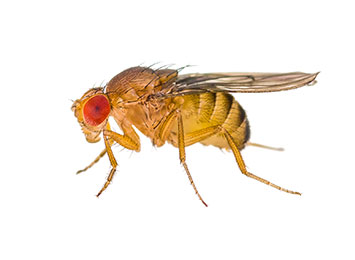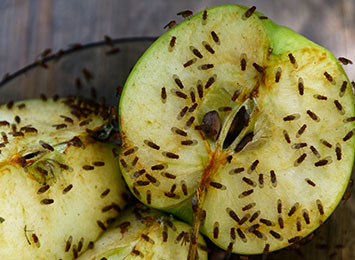Size: 3 to 4 mm long (25mm = 1 inch); maggots are 2.5 to 4.5 mm long
Color: Translucent brown or yellow, with red eyes.

Size: 3 to 4 mm long (25mm = 1 inch); maggots are 2.5 to 4.5 mm long
Color: Translucent brown or yellow, with red eyes.

Fruit flies swarm around their common food sources, which include any rotting, decaying, moldy, or dirty food. Check for fruit flies around your garbage, recycling, and drains.
Fruit flies reproduce in sources of moisture and the females lay their eggs in food sources so the emerging larvae can begin eating immediately. You may find them under your sink, near fruit or vegetables, in garbage containers or around condensation.
Scientific Order: Diptera (all true flies)
Family: Tephritidae or Drosophilidae
Common Species: Common Fruit fly or Vinegar fly (Drosophila melanogaster)
Finding fruit flies in your home means they’ve found a food source. To get rid of fruit flies, locate this food source and deprive them of it. Fruit flies can eat nearly any stored food, fruit, vegetable, liquid, or meat product once it begins to rot.
Take your garbage out every night. When you’re not using your garbage cans, keep them sealed. Clean them at least once a month. Store food in airtight, hard plastic containers whenever possible. Clean your kitchen and dining area after each meal. A clean home discourages pests of all kinds.
Fruit flies can seemingly show up overnight. How do fruit flies appear so suddenly? It’s no eerie supernatural power. They enter your home the same way most pests do – through open windows, gaps and cracks. They can also appear when eggs that were laid in fruit you bring home from the store or market hatch. Gross yes, but pest control uncovers some hard truths.

Fruit flies and their larva feed on the yeast created when fruits, vegetables, and other organic matter begins to ferment. Overripe fruits, rotten vegetables, the remains of alcoholic beverages, and leftover garbage are all common breeding grounds for fruit flies.
Fruit flies stay close to their food sources, flying over them to congregate and landing to eat. Fruit fly eggs and larvae remain inside their food sources and feed continuously. When they’re ready to pupate, they attach themselves to a surface near their food.
Fruit flies’ develop quickly or slowly depending on the temperature of their environment. A generation’s life cycle may complete in as few as eight days in 85°F environments, while it may take around 15 days at 68°F. Female fruit flies lay between 30 and 50 eggs per day at room temperature. In hotter environments, she’ll lay more and in colder environments, fewer.
A single female fruit fly may lay up to 500 eggs during her life. She lays these eggs on food sources, so hatched larvae may begin eating immediately. Larvae hatch quickly and feed continuously until they pupate. Fruit fly adults typically mate only a few hours after pupation.
Penn State College of Agricultural Sciences, Department of Entomology insect fact sheets, fruit fly entry
Identification of Flies, a step-by-step guide by the Virginia Tech College of Agriculture and Life Sciences
“How to deal with indoor flies,” by the Cornell University New York State Integrated Pest Management program
Unfortunately, in the fruits and vegetables we often eat. Female flies deposit eggs on these food sources so that the hatchlings can begin eating soon after they emerge. Wash all produce when you get home to remove eggs and nymphs.
Fruit flies have highly developed brains relative to their size; an adult fruit fly has more than 100,000 neurons that form discreet circuits for dictating complex behaviors.
Fruit flies are attracted to moisture, which they need to drink and reproduce. Dirty dish cloths, floor mops, moist towelettes, sponges, and dripping or leaking faucets may attract flies.
No. Fruit flies do not need blood like other insects and do not have biting mouth parts. If something is biting you, it’s another type of insect.
Fruit flies are not disease vectors that carry viruses, but they can transfer bacteria and germs like salmonella or listeria from dirty surfaces they’ve been on. These germs can then lead to food poisoning.
In optimal conditions, fruit flies can live 40-50 days. Typically, however, they only last for a couple of weeks.
No. While they are both small and equally obnoxious, fruit flies are more like other flies with rounded bodies and red eyes. Gnats are thinner, like a mosquito and have dark eyes and longer legs.
The most common way to dispense fruit flies is to create a trap using apple cider vinegar as bait. Clean infested drains with boiling water or bleach to kill flies and eggs. Make sure you wash all produce when you get home to remove eggs and larvae.